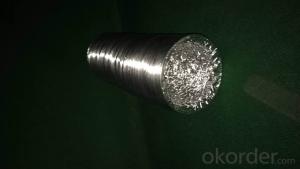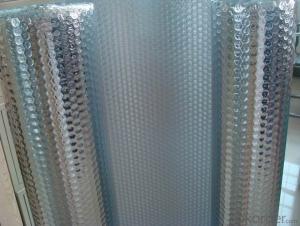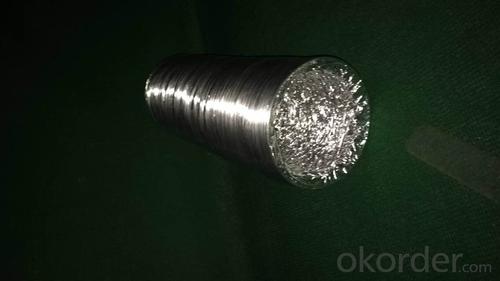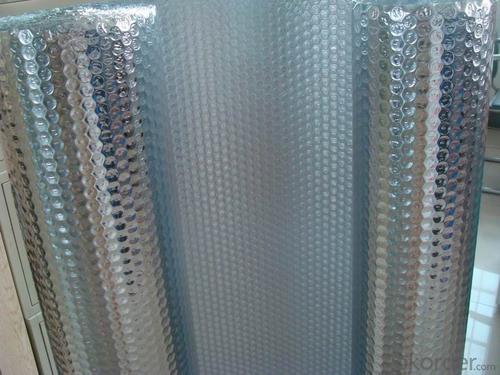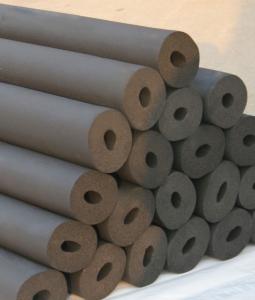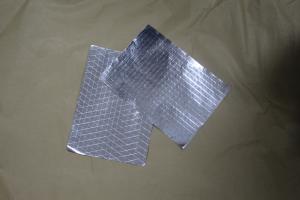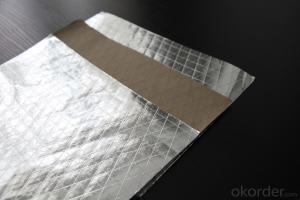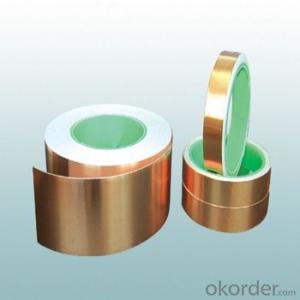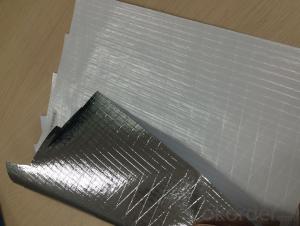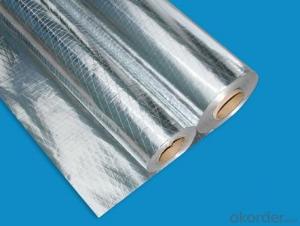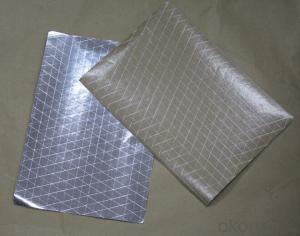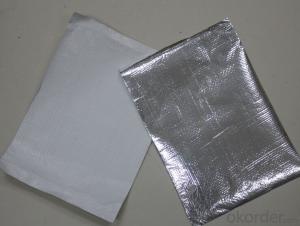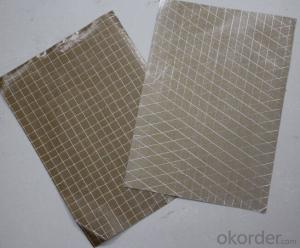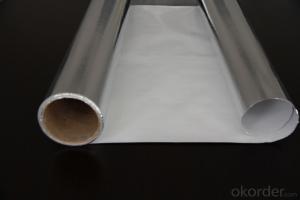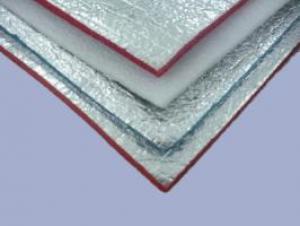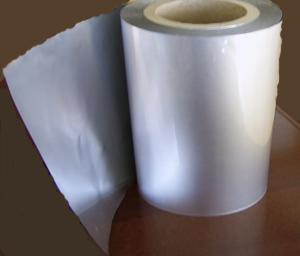Aluminum Foil Facing Flexible Ducts S/B Relax Insulation and Bubble Foil AL+PET
- Loading Port:
- Tianjin
- Payment Terms:
- TT OR LC
- Min Order Qty:
- 12 m²
- Supply Capability:
- 30000 m²/month
OKorder Service Pledge
OKorder Financial Service
You Might Also Like
Specifications
aluminum foil bubble insulation manufacture
thermal insulation
Construction:
Tri-directional scrim Heat Sealing Aluminum Foil : Corrosion resistance Coating/Foil: 7Microns/anti-heat adhesive/Kraft: 60 or 50gsm /Tri-way Scrim/Vinyl: 25Micons.
Application:
Heat Sealing Aluminum Foil is suitable for on-line lamination with thermal insulation such as glass wool blanket, rock wool or mineral wool by heating.
An thermal insulation facing to block radiant heat coming into house through the roof and walls during the summer and retain indoor heat generated during the winter. Heat Sealing Aluminum Foil facing also used as a water vapor barrier in air conditioning ductworks and cold rooms.
Benefit:
Heat FSK Facing is no need applying extra adhesive. Better corrosion resistance.
Does not contain hazardous chemicals or harmful materials that cause itching or respiratory problems.
A radiant barrier stops 97% of radiant heat transfer which improves the performance of the insulating material. Scrim reinforced for strength and durability.
Roll Width: 1.2M, 1.25M.etc
Roll Length: Up to 2500M.
- Q: This question asks for instructions on how to store aluminum foil after it has been used.
- <p>To store aluminum foil facing after use, first, wash and dry it thoroughly to remove any residue. Roll it up tightly, starting from the end that has been used, to keep the cleanest part of the foil on the outside. You can also use a rubber band or a piece of tape to secure the roll. Store it in a cool, dry place, away from direct sunlight to prevent it from losing its shine and becoming brittle. If you have a dispenser, you can also reinsert the foil back into the dispenser for neat and organized storage.</p>
- Q: This question asks for the optimal method of storing aluminum foil to maintain its usability and prevent damage.
- <p>The best way to store aluminum foil is to keep it in a cool, dry place, away from direct sunlight and heat sources. It's advisable to store it in its original box or a resealable plastic container to prevent it from getting crumpled or damaged. Some people prefer to store it with the shiny side facing out for easier identification, while others prefer the dull side out to reduce glare. It's important to ensure that the foil is tightly rolled to prevent it from unraveling or getting tangled.</p>
- Q: What are the distinctions among various food wraps found in stores?
- <p>Yes, there are differences among food wraps available on the market. They vary in material, such as plastic, aluminum foil, parchment paper, and beeswax wraps. Each type has distinct properties: plastic cling wrap is versatile but not microwave-safe; aluminum foil conducts heat well and is reusable but can tear easily; parchment paper is ideal for baking and can withstand high temperatures; and beeswax wraps are eco-friendly, reusable, and can be used in the fridge or freezer but not for high-heat cooking. Each type also differs in terms of environmental impact, cost, and suitability for different food storage and cooking needs.</p>
- Q: Is it safe and effective to use aluminum foil facing material for wrapping rice for storage purposes?
- <p>Using aluminum foil facing to wrap rice for storage is not recommended. Aluminum foil facing is not designed for food contact and may contain chemicals that could contaminate the rice. Instead, opt for food-grade materials like plastic bags or containers specifically designed for food storage. These materials are safer and help maintain the freshness and quality of the rice.</p>
- Q: Is it safe and effective to use aluminum foil as a facing material for making soup?
- <p>Using aluminum foil directly to make soup is not recommended. Aluminum foil is not designed for cooking food as it can react with acidic or alkaline ingredients, potentially releasing harmful substances into the food. It is also not heat resistant and can melt or warp when exposed to high temperatures. For safe and effective soup making, use materials specifically designed for cooking, such as stainless steel, enameled cast iron, or non-stick pots. These materials are safe for cooking and can withstand high temperatures without compromising the quality or safety of your soup.</p>
- Q: What are the most effective ways to clean surfaces that have aluminum foil applied to them?
- <p>The best cleaning methods for aluminum foil facing involve gentle cleaning to avoid damaging the foil. Use a soft cloth or sponge with warm water and mild dish soap to wipe the surface. Avoid abrasive cleaners or scrubbing, as this can scratch or tear the foil. For stubborn stains, a mixture of baking soda and water can be applied as a paste and gently rubbed with a soft cloth. Always rinse thoroughly and dry the surface to prevent water spots and maintain the integrity of the aluminum foil.</p>
- Q: Can aluminum foil be used as a substitute for a pizza stone or baking sheet when making pizza?
- <p>Yes, you can use aluminum foil as a makeshift surface for making pizza if you don't have a pizza stone or baking sheet. However, it may not provide the same even heat distribution or crispiness as a pizza stone. Ensure the foil is heavy-duty to prevent tearing and preheat it with the oven to get a better result. Keep in mind that the foil can reflect heat, which might affect the bottom crust's texture. It's a good alternative, but for consistent quality, using a proper pizza stone or baking sheet is recommended.</p>
- Q: Is it safe to use aluminum foil as a liner in a slow cooker, and are there any potential risks or benefits?
- <p>Using aluminum foil as a facing in a slow cooker is generally safe. It can help with easy cleanup and may distribute heat evenly. However, it's important to ensure that the foil doesn't touch the heating element, as this can cause damage to both the foil and the slow cooker. Additionally, while aluminum foil is non-toxic and generally safe, there are concerns about potential leaching of aluminum into food, especially with acidic foods. For health-conscious individuals, using a slow cooker liner made from materials like silicone or stainless steel might be a better alternative.</p>
- Q: Is it safe to store food in a container where the aluminum foil is in direct contact with the food?
- <p>Storing food in a container lined with aluminum foil facing the food is generally safe as long as the foil is food-grade and the food is not acidic or high in salt. Aluminum foil is non-toxic and does not react with most foods. However, it's important to avoid using it with acidic foods like tomatoes or citrus fruits, as this can cause the foil to corrode and release aluminum. Also, avoid using it with high-salt foods as this can lead to a chemical reaction. Always ensure the foil is clean and undamaged to prevent any potential contamination.</p>
- Q: This question asks for the method to wrap a hot pan using aluminum foil, with specific instructions on how the foil should face.
- <p>To wrap a hot pan with aluminum foil, first ensure the pan is stable and on a heat-resistant surface. Take a large piece of aluminum foil, about twice the size of the pan. Hold one corner of the foil and drape it over the pan, allowing the shiny side to face the pan. Gently press the foil against the pan, working your way around the edges to cover the entire surface. Ensure the foil is snug but not too tight to avoid tearing. The shiny side facing the pan will help reflect heat and protect the pan's surface. Be cautious while handling the hot pan and aluminum foil to avoid burns.</p>
Send your message to us
Aluminum Foil Facing Flexible Ducts S/B Relax Insulation and Bubble Foil AL+PET
- Loading Port:
- Tianjin
- Payment Terms:
- TT OR LC
- Min Order Qty:
- 12 m²
- Supply Capability:
- 30000 m²/month
OKorder Service Pledge
OKorder Financial Service
Similar products
Hot products
Hot Searches
Related keywords
